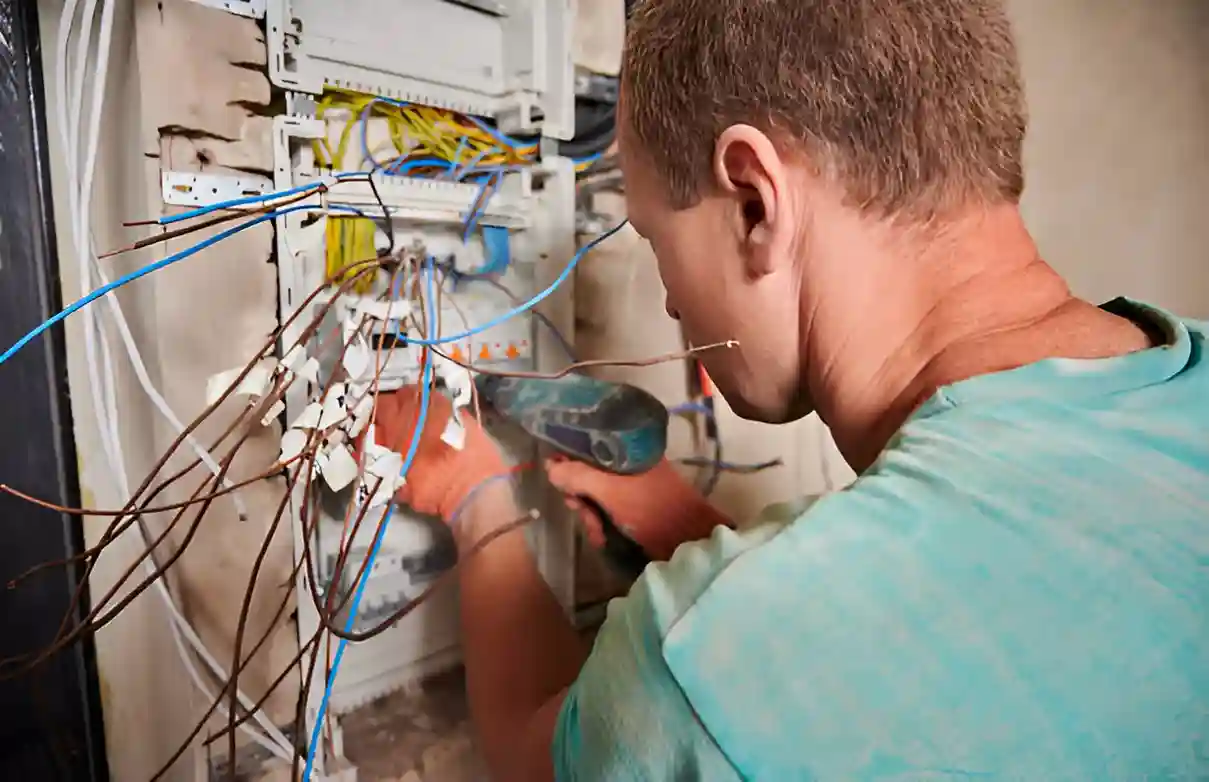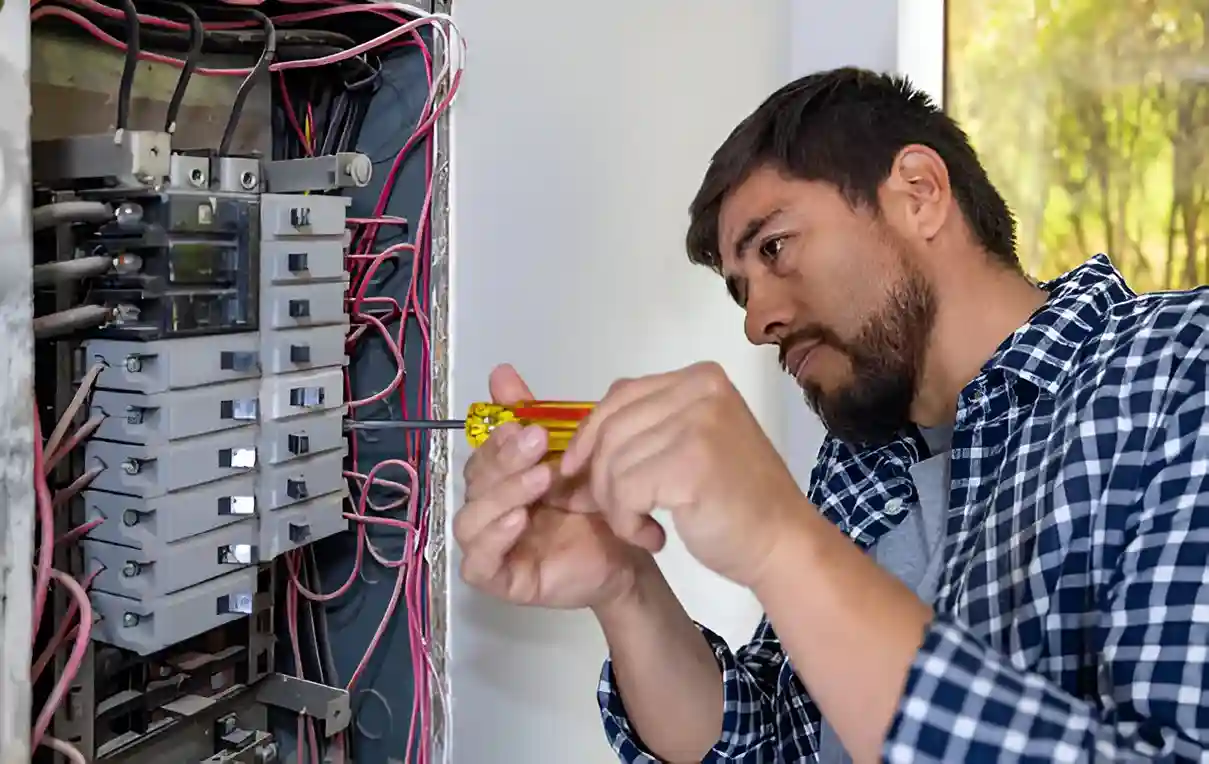
Replacing an electric fuse box in the UK typically costs between £300 and £800. This range differs based on factors like the type of fuse box and local labour costs. Understanding these elements is integral for homeowners planning an upgrade. Since safety is a significant concern, knowing when and why to replace an old fuse box is essential for making informed decisions about electrical safety and efficiency.
Key Takeaways
- The average cost to replace an electric fuse box in the UK varies from £300 to £800, depending on several factors.
- The labour cost of changing electric fuse box varies significantly based on the electrician’s experience and the regional rates.
- Upgrading existing wiring or adhering to local regulations can raise total costs.
- Standard fuse boxes are usually cheaper than advanced consumer units, affecting their cost.
- Getting several quotes from electricians is advised to ensure a fair price comparison.
Understanding the Cost of Changing Electric Fuse Box
When considering the cost of changing electric fuse box, homeowners often navigate a complex array of factors that affect pricing. The first aspect to consider is the type of fuse box being installed. Standard models generally cost less than more advanced, high-capacity systems.
Labour costs also significantly influence expenses, as professional electricians charge different rates based on their experience and location. Furthermore, the state of existing wiring can impact the total cost; outdated or damaged wiring may require additional upgrades, increasing the total cost of changing electric fuse box.
Furthermore, local regulations and permits may lead to extra costs, as adhering to safety standards is fundamental. In the end, a comprehensive evaluation of these factors will offer a clearer understanding of the financial commitment involved in replacing an electric fuse box.
The importance of replacing an old fuse box for safety reasons.
Replacing an old fuse box is essential for maintaining electrical safety in a home, as outdated systems can pose significant risks.
Older fuse boxes may not fully comply with current safety standards, which can lead to dangers such as electrical fires or electrocution. Many older models lack essential features like residual current devices (RCDs), which are vital for preventing electric shocks.
Furthermore, as the electrical demands of modern households increase, due to the widespread use of appliances and technology, old fuse boxes may struggle to handle the load, leading to overheating or circuit failures.
Typical Cost of Changing Electric Fuse Box in the UK
The typical cost of changing electric fuse box in the UK ranges from £300 to £800. The price varies based on factors like location, fuse box type, and the complexity of the installation. Homeowners should be aware that prices can vary significantly based on regional labour rates and the specific needs of their electrical system.
For instance, a simple replacement in a typical home might be at the lower end of the cost spectrum, while a more complex installation, needing extra wiring or modifications, could raise the costs significantly. Furthermore, choosing between a standard fuse box and a more advanced consumer unit will also influence the overall price.
Property owners should gather several quotes from qualified electricians to ensure a fair assessment and understand the scope of work involved before making a decision.
H2: Key Factors That Affect the Cost of Changing Electric Fuse Box
Several key factors affect the cost of changing electric fuse box, making it essential for homeowners to understand these elements before proceeding with any work. To begin with, the complexity of the existing electrical system is a significant factor; older systems may require additional modifications to accommodate a new fuse box.
Furthermore, the geographical location influences the labour cost of changing electric fuse board, as electricians may charge different rates depending on local demand and living expenses. Thirdly, the condition of the wiring can affect the overall expense; if outdated or unsafe wiring is present, it might need replacing, thereby increasing the total cost.
Additionally, the time of year can affect the cost of changing electric fuse box, as demand for electrical services may rise during certain seasons. Homeowners should also consider the electrician’s qualifications and experience level, which can impact the cost of changing an electrical fuse box but often relate to the quality and reliability of the work done.

Fuse Box Type and Specifications (RCD, RCBO, etc.)
When considering the change of an electric fuse box, understanding the various types and specifications available is essential. Common types include Residual Current Devices (RCDs) and Residual Current Circuit Breakers with Overcurrent (RCBOs). Each serves distinct purposes, influencing safety and functionality in electrical installations.
| Fuse Box Type | Description |
|---|---|
| RCD | Protects against electric shocks by shutting off the circuit when a fault occurs. |
| RCBO | Combines RCD and circuit breaker functions, offering protection against overloads and earth faults. |
Selecting the appropriate fuse box type is crucial for electrical safety and regulatory compliance. Understanding these specifications helps homeowners make informed decisions, ultimately impacting the overall cost of changing electric fuse box and the effectiveness of the installation.
Signs Your Fuse Box Needs Changing
How can homeowners determine if their fuse box needs to be replaced? Several signs can indicate the need for a new fuse box.
First, frequent tripping of circuit breakers or blown fuses suggests that the current system cannot handle the electrical load. Additionally, if the fuse box displays rust or corrosion, it may be a sign of deterioration that could compromise safety.
Homeowners should also be aware of any burning smells or visible scorch marks, which indicate potential electrical danger. Moreover, an outdated fuse box, particularly one with ceramic fuses, may not meet modern safety standards.
Finally, if the household has undergone significant renovations or increased electrical demands, an upgrade may be necessary. Recognising these warning signs can help guarantee the home remains safe and functional, ultimately prompting timely action to replace an ageing or inadequate fuse box.
How Long Does It Take to Change a Fuse Box
Determining the need for a new fuse box can lead homeowners to wonder about the time commitment involved in such a replacement. Replacing a fuse box typically takes several hours up to a full day, depending on various factors.
- Complexity of the electrical system: Older homes may have more complicated wiring, requiring additional time for safe installation.
- Accessibility of the fuse box: If the location is difficult to reach, this can extend the time needed for the replacement.
- Type of fuse box: Upgrading to a more advanced system may involve additional steps, influencing the overall timeframe.
Homeowners should consult a qualified electrician to receive a more accurate estimate tailored to their specific circumstances.
Understanding the time commitment can help plan for any inconvenience that may arise during the replacement process.

Legal and Safety Reasons to Replace Your Old Fuse Box
Replacing an old fuse box is essential for guaranteeing compliance with current electrical regulations and enhancing overall safety in the home. Modern fuse boxes are designed with advanced safety features that protect against electrical threats, such as overloads and short circuits. Additionally, outdated fuse boxes may not meet the latest legal requirements, which can lead to potential fines or issues when selling a property.
| Reason for Replacement | Explanation |
|---|---|
| Compliance with Regulations | Guarantees adherence to updated electrical safety laws. |
| Enhanced Safety Features | Protects against electrical faults and risks. |
| Increased Property Value | Modern installations can attract buyers. |
| Insurance Compliance | Helps meet the terms set by insurance providers. |
| Peace of Mind | Provides reassurance about household safety. |
Updating to a new fuse box not only mitigates risks but also assures a safer living environment for all occupants.
Is Upgrading Your Fuse Box a Good Investment?
Upgrading a fuse box can be a wise financial choice, especially for homeowners aiming to improve safety and efficiency.
An updated fuse box not only meets modern electrical standards but also provides several advantages that can justify the investment.
- Enhanced safety: Minimise the danger of electrical fires and risks.
- Enhanced Capacity: Enables the connection of more electrical devices and appliances, meeting modern needs.
- Higher Property Value: Improvements can make a home more appealing to prospective buyers.
In addition to these benefits, a new fuse box can lead to lower insurance premiums, as insurers often favour homes equipped with updated safety features.
Why Choose a Qualified Electrician for the Job
Choosing a qualified electrician for the installation or upgrade of a fuse box is essential, as their expertise guarantees compliance with safety regulations and electrical standards. They are well-versed in local building codes and regulations, which helps avoid costly fines or legal issues associated with non-compliance.
Furthermore, hiring a professional reduces the risk of faulty installations that could lead to electrical fires or equipment damage. Qualified electricians also typically offer warranties on their work, providing an additional layer of security for homeowners.
Their access to the right tools and materials assures that the job is completed efficiently and to a high standard. London Landlord certificates offer the most reliable service at affordable prices.
Frequently asked questions.
Conclusion
In conclusion, the cost of changing electric fuse box in the UK generally ranges from £300 to £800, depending on factors such as the type of fuse box and labour charges. Prioritising safety and complying with regulations makes replacing an old fuse box essential. Ultimately, installing a new fuse box boosts safety and increases the electrical system’s overall efficiency.







